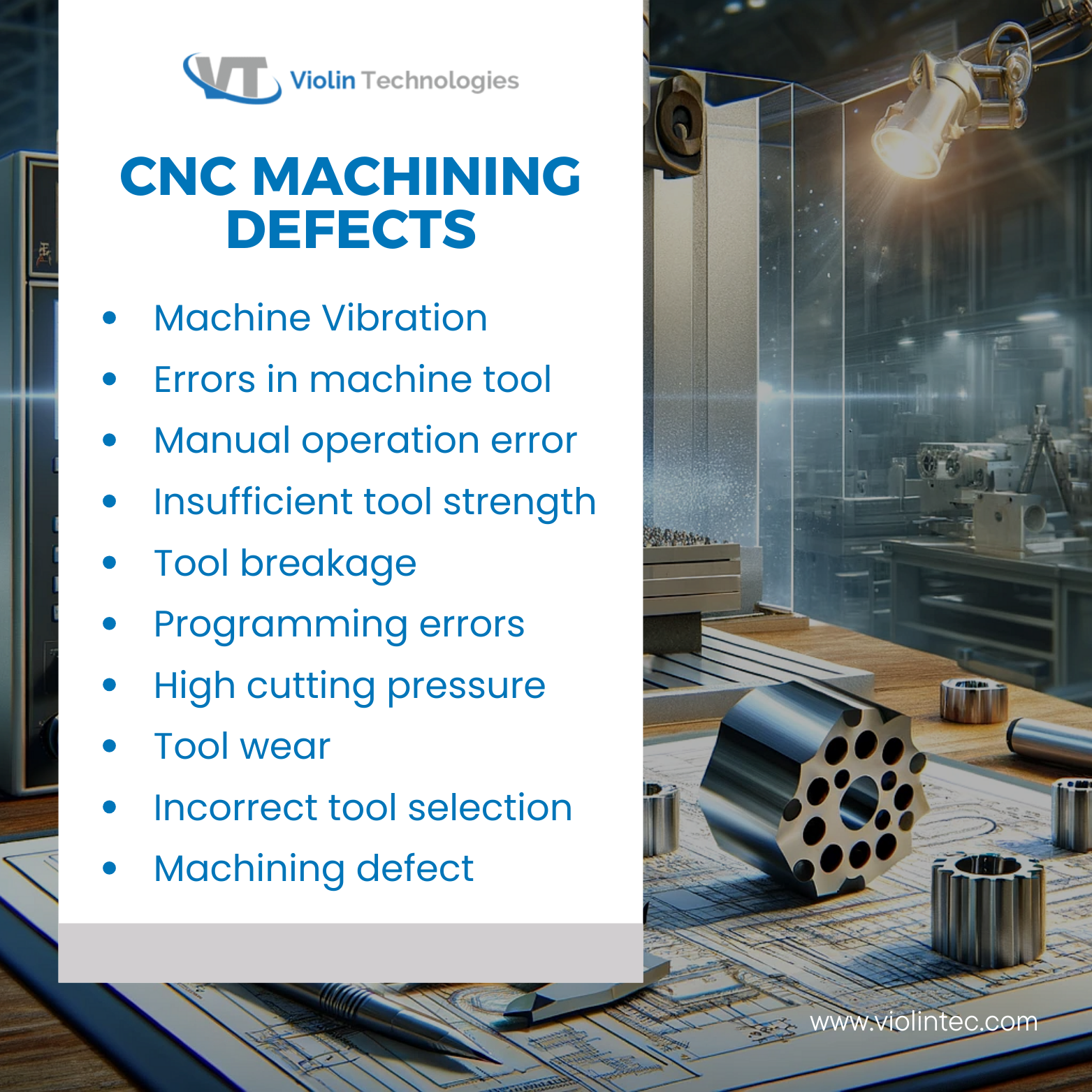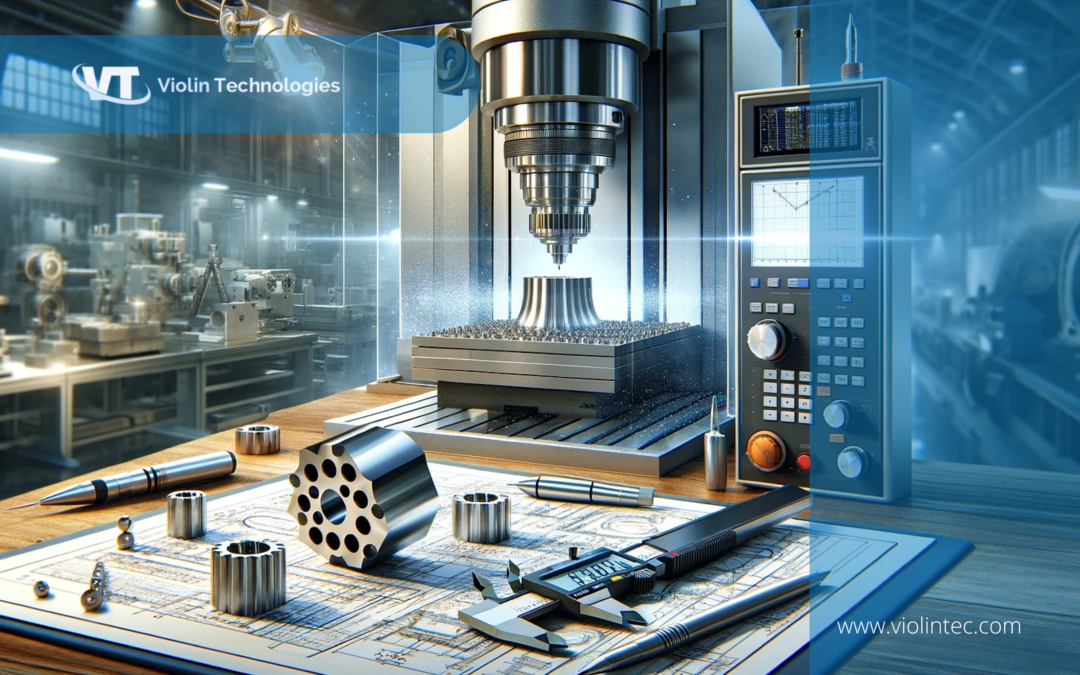In this blog, let’s explore the top 10 CNC machining defects and effective solutions and improvement methods to address them and avoid machine failures.
What we cover in this blog?
Key Takeaways
- CNC machining encounters certain defects, impacting final part quality.
- Addressing defects requires understanding the machining process, tooling, and workpiece materials.
- Recognizing and mitigating defects involves understanding tool-workpiece interactions.
- Regular monitoring and adjustment optimize part quality in CNC machining operations.
CNC Machining Defects And How To Fix Them
1. Machine Vibration
One of the common defects in CNC machining is vibration of the machine, which implies the oscillatory movement of the machine and its components during operation. A CNC machine vibrates due to various reasons, such as worn machine spindle bearings, improper cutting parameters, and unbalanced tool holders, leading to reduced accuracy, tool life, and rigid machined surface finish.
Solution
- Balancing tool holders and ensuring proper seating of cutting tools can minimize the vibration during machining.
- Lubrication of moving parts, replacing worn components, and adjusting the spindle speed are some improvement methods.
2. Errors In Machine Tool
Machine tool errors are misalignment, spindle runout, and backslash, which can lead to dimensional inaccuracies, machining defects, and poor surface finish.
Solution
- Conducting periodical machine tool calibration and adjusting alignment can retain accuracy and retain ability.
- Addressing mechanical issues through repair or maintenance can prevent the degradation of quality.
- Implementing compensation techniques like tool radius compensation and backslash compensation can mitigate the impacts of machine tool errors.
3. Manual operation error
Manual operation errors are the inaccuracies or mistakes that happen during the operation of machinery. In CNC machining defects, these errors refer to incorrect tool changes, operator mistakes, and improper workpiece material that could lead to production delays.
Solution
- The provision of comprehensive training for operators to provide proficiency in machine operation, tool handling, and workpiece setup is one of the best ways to avoid manual operation errors.
- Executing standard operating techniques and checklist protocols can reduce the risk of manual operation errors.
- Encourage the operators to report errors or anomalies for resolution.
4. Insufficient tool strength
Insufficient tool strength is a situation where the cutting tools used in machining operations lack the required durability, toughness, and rigidity to withstand the stresses and forces that occur during cutting. This lack of strength in the cutting tool can lead to several issues and defects, such as tool breakage, tool deflection, reduced productivity, surface finish issues, tool wear, and many more.
Solution
- The selection of tools with sufficient strength to withstand the cutting forces is a primary step to avoid defects.
- Usage of shorter tool lengths and reduced overhangs can minimize the tool deflection and vibration.
- Choose ceramide cutting tools or carbide for improving performance in demanding fields.
5. Tool Breakage
Tool breakage can be caused by excessive cutting, improper tool selection for the requirement, and machining of hard materials. Tool breakages not only interrupt but also tend to damage the workpieces and compounds.
Solution
- Optimizing the cutting parameters can reduce the cutting forces and bring down the risk of breakage.
- Using high-performance cutting tools that are designed for specific materials and machining operations.
- Implementation of real-time monitoring systems for detecting breakage.

6. Programming errors
Programming errors fetch the wrong toolpaths, machining sequences, or tool selections, leading to defective parts. The most common programming errors are incorrect feed rates, G-code syntax mistakes, and tool offsets.
Solution
- Verify CNC programs using simulation software or test cuts on scrap material.
- Conduct program sheet reviews to identify and correct mistakes before machining.
- Conduct training programs for programmers to reduce the likelihood of programming mistakes.
7. High cutting pressure
High pressure is the significant force exerted on the cutting tool during machining operations. It is an outcome of the interaction between the cutting tool and workpiece material as the tool removes material during the cutting process. Cutting pressure is influenced by many factors, including tool geometry, cutting parameters, workpiece material properties, and machining conditions. A few typical manifestations of high cutting pressures are tool wear, machine and fixture stability, energy consumption, workpiece deformation, and many more.
Solution
- Optimization of cutting speed, depth of cut, and feed rate to minimize cutting pressure while maintaining efficiency.
- Usage of coolant or cutting fluids to dissipate heat or lubricate the cutting edge minimizes friction and prolongs the tool’s life.
- Implement trochoidal milling machines or other highly productive machining strategies to minimize high cutting forces.
Choosing the right contract manufacturers plays a critical role in producing precise and client-specific products.
8. Tool Wear
Tool wear occurs when cutting tools lose their effectiveness and sharpness due to repeatability, which could result in dimensional inaccuracies, increased machining time, and poor surface finish.
Solution
- Regular inspection of cutting tools for signs of wear and replacement of the cutting tool if needed are primary steps to avoid tool wear.
- Optimizing cutting parameters like feed rate, cutting speed, and depth of cut to reduce the tool wear.
- Prioritize usage of high-quality cutting tools and coatings designed for longevity.
9. Incorrect tool selection
Selection of the wrong tool for a specific machining operation can lead to poor surface finish, machining defects, and tool wear. Different materials and machine processes need particular tool geometry, cutting speeds, and coatings.
Solution
- Consider tool manufacturer’s recommendations and machining handbooks to select the right cutting tools for a specific requirement.
- Consider parameters like cutting forces, workpiece material, and desired surface finish while opting for tools.
- Conducted regular evaluations of tool performance and performed required adjustments to optimize the machining process.
Precision-machined components are a vital requirement for a particular application. Choosing the right tool based on your application can turn the tables in the manufacturing process.
10. Machining Defect
Machining defects include a wide range of issues that include dimensional deviations, surface roughness, and improper tolerances. These defects can arise from various sources, such as programming errors, instability of machine tools, and tool wear.
Solution
- Execute full-fledged quality measures like post-machining inspections, dimensional checks, and surface finish analysis.
- Make required adjustments on machining parameters, toolpath strategies, and tool selection to address particular defects.
- Perform regular maintenance of CNC machines to minimize the defects caused by machine misalignment or wear.
Conclusion
By addressing these above common defects in CNC machining with proactive measures and effective solutions, manufacturers can optimize machining processes, enhance product quality, and maximize productivity. Regular maintenance, thorough quality control, and continuous improvement initiatives are essential for minimizing defects and achieving consistent machining excellence.
A contract manufacturing company in Chennai excel in optimizing CNC machining processes for precision parts. Our partnership with trustworthy supply chain partners, as well as the important insights gained from customers, are critical to our ongoing improvement and commitment to reducing CNC machining failures.
FAQs
What are common CNC machining defects?
Common defects include surface irregularities, tool breakage, chatter marks, dimensional inaccuracies, and improper surface finishes.
How do I identify CNC machining defects?
Defects can be identified through visual inspection, dimensional measurement, surface quality analysis, and monitoring machining parameters for anomalies.
What causes CNC machining defects?
Defects can result from various factors, such as incorrect tool selection, improper machining parameters, tool wear, material inconsistencies, and programming errors.
How can CNC machining defects be resolved?
Resolving defects involves adjusting machining parameters, optimizing tooling and tool paths, ensuring proper tool maintenance, addressing material inconsistencies, and refining programming to correct errors.

Amulya Sukrutha
About the Author
Amulya Sukrutha, passionate computer science engineer specialized in Data science field. I also describe myself as a enthusiastic strength and endurance trainee. I have played professional Tennis during my early years and found my path in Software development and machine learning later. I’m also passionate about creating content, and learning about new technologies.

